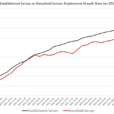Uncertainty about the health of the global economy led investors to flee U.S. equities during Q3, primarily driven by worries about China’s growth prospects and the Federal Reserve’s decision to not raise rates. Sure, there are plenty of real and perceived headwinds, but on balance it seems that a recession here at home is not in the cards. And when you consider sentiment and the technical picture, it appears that a continuation of Friday’s bounce is in store. The question remains as to whether the seasonally strong Q4 will be able to propel the bulls through levels of resistance that have built up.
In this weekly update, I give my view of the current market environment, offer a technical analysis of the S&P 500 chart, review our weekly fundamentals-based SectorCast rankings of the ten U.S. business sectors, and then offer up some actionable trading ideas, including a sector rotation strategy using ETFs and an enhanced version using top-ranked stocks from the top-ranked sectors.
Market overview:
On a total return basis, the S&P 500 large caps fell -6% during Q3, and mid- and small-cap stocks also struggled as the S&P 400 and the S&P 600 fell -8% and -9% during the quarter, respectively. Defensive strategies outperformed, and defensive sector Utilities held up the best, while Energy and Basic Materials struggled in the face of falling commodity prices.
Global headwinds are evident, particularly in China, but even our domestic data shows weakness. ISM manufacturing report last week was barely above 50, and New Orders and Backlogs are quite weak. And then the monthly employment report disappointed. Looking at the imminent Q3 earnings reports from among S&P 500 companies, estimated earnings are expected to fall -4.7% quarter-over-quarter (the first decline since 3Q2009), while revenues are expected to fall -2.8% from last year (which would be the third quarter in a row with declines). The best reports are expected to come from Consumer Discretionary, Telecom, and Healthcare.
The numbers are growing among those forecasting either a recession or a bear market, or both. For example, Doubleline Capital’s Jeffrey Gundlach thinks risk assets like stocks and junk bonds are quite vulnerable to the downside right now.
But on the other hand, household incomes and purchasing power are up. Median household income (adjusted for inflation) grew in August to a post-recession high of nearly $56k. And jobless claims are at the lowest level since 1973 as layoffs are few and far between. Auto sales are accelerating toward record levels, hitting an annualized rate of 18.2 million in September, which is near record levels, and the average new-car price paid is about $31k. Global monetary policy remains accommodative — including in the U.S. — and it will remain so even if the Fed starts raising the fed funds rate. Banks are well capitalized. Corporate coffers are flush with cash. Homebuilders are doing well, with rising sales in both residential and commercial properties.
Nevertheless, with the focus on jobs numbers and inflation, fed funds futures are forecasting only a 31% chance of a quarter-point rate hike in December. The 10-year yield closed Friday at 1.99%. Put in context, its 52-week range is 1.65-2.49%. The iShares 20+ Year Treasury Bond ETF (TLT), rose more than 5% during Q3.
Even with recent bouts of market weakness, volatility has not been rising much. The CBOE Market Volatility Index (VIX), a.k.a. fear gauge, closed Friday at 20.94, which is barely above the 20 panic threshold. Some institutional portfolio managers see this as an indication of a continuation to the stock rally.













Leave A Comment